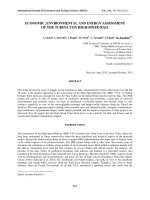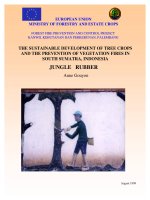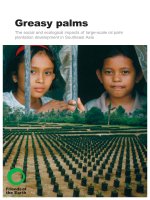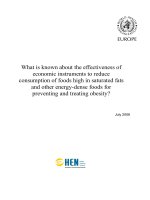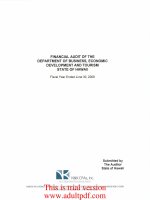Challenges endangering economic viability and ecological sustainability of crop diversification in Himachal Pradesh
Bạn đang xem bản rút gọn của tài liệu. Xem và tải ngay bản đầy đủ của tài liệu tại đây (285.74 KB, 8 trang )
Int.J.Curr.Microbiol.App.Sci (2018) 7(10): 2620-2627
International Journal of Current Microbiology and Applied Sciences
ISSN: 2319-7706 Volume 7 Number 10 (2018)
Journal homepage:
Original Research Article
/>
Challenges Endangering Economic Viability and Ecological Sustainability
of Crop Diversification in Himachal Pradesh
Nisha Devi* and R.S. Prasher
Department of Social Sciences, Dr. Y.S Parmar University of Horticulture and Forestry,
Nauni Solan 173230 (H.P), India
*Corresponding author
ABSTRACT
Keywords
Garrett’s ranking, High
value crops, Production
constraints and marketing
constraints
Article Info
Accepted:
20 September 2018
Available Online:
10 October 2018
The study was conducted in all the four zones of Himachal Pradesh with one
representative district from each zone. All is, however, not well with the ongoing process
of crop diversification in the state. Some impending challenges those endanger the
economic viability and ecological sustainability of cash crops were lack of irrigation
facilities, small land holding, fluctuating price, inadequate storage facilities, soil erosion,
loss of water holding capacity, lack of processing facilities and lack of proper knowledge
about the application of insecticides pesticides and fertilizers. The cultivation of high value
crops, have started showing increasing symptoms of unsustainability due to, among other
things, falling soil fertility, erratic weather conditions and the emergence of numerous
insects, pests and diseases. The adoption of same cropping sequence year after year has
caused the loss of micronutrients leading to deterioration in the overall soil health. The
high incidence of diseases has led to an excessive use of agrochemicals that has given rise
to a vicious cycle of falling productivity-more use of chemicals–further fall in
productivity, and so on. This has not only escalated the production cost but has also
affected environment and bio-diversity adversely.
Introduction
Agricultural transformation in a mountainous
state like Himachal Pradesh is circumscribed
by
mountain
specificities,
namely,
inaccessibility, fragility, marginality, niche
and human adaptation mechanism created by
unique vertical dimensions that distinguish
them from plains (Jodha, 1992). While the
first three specificities contribute in varying
degrees, inter alia, to physical isolation,
distance and high transportation costs and,
therefore, create formidable constraints for
agricultural transformation, the latter two
suggests the availability of potential for
growing a variety of micro niche based high
value cash crops. The proliferation of
extremely small and tiny holdings on account
of factors like continuing population pressure
on land coupled with general lack of rural
non-farm employment opportunities, liberal
laws of inheritance and resultant sub-division
of holdings, etc. are the major constraints in
boosting
agricultural
production
and
productivity and raising the levels of living of
a typical Indian farmer. The problem is more
2620
Int.J.Curr.Microbiol.App.Sci (2018) 7(10): 2620-2627
serious in mountainous states like Himachal
Pradesh where only 13 per cent of the total
geographical area is available for cultivation.
There is a preponderance of tiny holdings in
the state; about 88 per cent of the holdings are
small and marginal owning less than two
hectares of land and accounting for about 54
per cent of the operated area. The overall
average size of holdings is 1.00 ha (Census of
Himachal
Pradesh,
2011).
Therefore,
improving the production and productivity of
these tiny holdings and, in the ultimate
analysis, the level of living of marginal and
small farmers is a major challenge for the
planners and policy makers. An acceptable
and meaningful transformation will be
expected to improve productivity, build
resilience to farming systems, improve
livelihoods and reduce harm to the
environment.
Such critical practices and techniques include;
crop diversification through rotations and
intercropping, agroforestry, conservation
tillage, cultivation of drought-resistant crops,
water harvesting and integrated soil fertility
management (Faures et al., 2013). Truscott et
al., (2009) considers crop diversification an
environmentally sound alternative to the
control of parasites and in the maintenance of
soil fertility in agriculture.
Materials and Methods
Data was collected from all the four agroclimatic zones of Himachal Pradesh for the
agricultural year 2016. One district from each
agro-climatic zone was selected purposively.
Bilaspur (Shivalik Hill Zone), Solan (Mid Hill
Zone), Kullu (High Hill Zone) and Kinnaur
(Cold Dry Zone) districts was chosen for
reasons of high significance and scope of
introducing diversification activities into the
farming systems of area. Two blocks from
each selected district were purposively
selected, one relatively highly diversified and
one relatively least diversified in consultation
with district level officers. For the selection of
sample, three stage stratified random sampling
design was adopted; with development block
as a primary unit, village as a secondary unit
and sampled farmer as an ultimate unit.
Accordingly, 30 households were selected
from each block thus making total sample size
of 240 from four agro-climatic zones of
Himachal
Pradesh.
Garrett’s
Ranking
Technique was used to prioritize the imminent
challenges/constraints.
Garrett’s ranking technique
Per cent Position= 100 (Rij -0.50)/ Nij
Where,
The crop diversification towards selective
high value crops including fruits and
vegetables, compatible with the comparative
advantage of the region, is recommended as an
effective strategy in raising incomes,
generating employment opportunities and
alleviating poverty among small and marginal
households (Vyas, 1996; Joshi et al., 2007).
According to Njeru (2013) crop diversification
not only allows more efficient utilization of
agro ecological processes, but also provides
diversity for human diet and improves income
which improves the purchasing power for the
household for buying other foods.
Rij = Rank given to the ith item by the jth
individual,
Nij = Number of items ranked by the jth
individual,
The per cent position of each rank was
converted into scores using Garrett’s table.
For each constraint score of the individual
respondent were added. Thus, mean score for
each constraint was ranked by assigning
higher rank (1) to highest value Garrett mean
score.
2621
Int.J.Curr.Microbiol.App.Sci (2018) 7(10): 2620-2627
Results and Discussion
Economic
viability
sustainability
and
ecological
and constraints in their production and
marketing with which they are confronted
with, are needed to be identified.
Production constraints
Agriculture is one of the sectors significantly
affected by climate change and variability.
Seasonality dynamics, increased frequency of
droughts (especially mid-season dry spells),
increased temperatures, altered patterns of
precipitation and intensity are some of the
extreme weather events. Declining crop
yields,
increased
agricultural
risks,
diminishing soil fertility and environmental
degradation are some of the main challenges
which continue to threaten societal goals of
improving food, income and nutrition security
especially in smallholder farming. It,
therefore, calls for a significant transformation
in agriculture to withstand the emerging
challenges (Tewari et al., 1992).
Farm profitability from crops were considered
to be the indicator of economic viability. Farm
productivity was measured through physical
yield of crops and crop yield data were
collected through a household survey. Farm
profitability was then determined based on
financial return per unit of land and the
financial return was analyzed through BenefitCost ratio. It was considered that if the
benefit-cost ratio found greater than 1 then
that crop is economically viable in that area.
All the high value crops were found viable in
all the four agroclimatic zones of Himachal
Pradesh.
Constraints/ Challenges
High value crops like fruits, vegetables and
flowers are confronted with numerous
constraints due to their highly perishable
nature, high-tech requirements, costly planting
material/seeds, inputs, etc. Thus, for
encouraging the production and efficient
marketing of these crops, various problems
In production constraints at overall level lack
of irrigation facilities was the major problem
found in the study area (Table 1). This was the
major problem with highest rank in Zone-I,
Zone-II and Zone-III. It was expected that the
unreliable rainwater would impose severe
limitations on the agricultural production.
Unreliable rainfall is a major constraint in the
diversification of agriculture. While in ZoneIV small land holding was the major problem.
It was also highly severe problems at state
level. There is a preponderance of small land
holdings in Himachal Pradesh. According to
Agricultural Census of Himachal Pradesh
(2010-11), small and marginal farmers
together constitute 88% of the total population
of the state. The average size of holding was
1.0 hectares in 2010-11. Fluctuating
production, unfertile holding and cash
shortage when needed also contributed to
production constraints. Problems like nonavailability of skilled labour at operation
period, costly labour, non-availability of
quality seed and planting material, fertilizer
and Plant protection chemicals not available in
time
were
also
observed.
India
lacks modernized infrastructure for promoting
the agriculture sector. Rudimentary policies
and old fashioned equipment’s and practices
used by farmers in India are not sustainable,
resulting in low productivity for many
agricultural commodities (Dwivedy, 2011).
Marketing constraints
Agri-commodity sector is still lacking in a
well-developed, organised and integrated
market for spot trading of commodities.
Farmers quite often are faced with a risk of
what to grow and when and where to sell.
2622
Int.J.Curr.Microbiol.App.Sci (2018) 7(10): 2620-2627
Table.1 Production constraints being faced by the farmers
Constraints
Small land holding
Cash shortage when needed
Fertilizer and Plant protection
chemicals not available in time
Un-fertile holding
Costly labour
Non-availability of skilled labour
at operation period
Fluctuating production
Lack of irrigation facilities
Non-availability of quality seed
and planting material
Zone-I (Bilaspur)
GMS*
Rank
72.78
V
76.33
IV
62.12
VIII
Zone-II (Solan)
GMS*
Rank
70.63
V
73.72
III
63.60
VIII
Zone-III (Kullu)
GMS*
Rank
76.18
II
64.75
VIII
65.93
VII
Zone-IV (Kinnaur)
GMS*
Rank
77.00
I
67.48
VIII
67.58
VII
Over all
GMS*
Rank
74.15
II
70.57
V
64.81
IX
78.33
68.20
64.13
II
VI
VII
72.17
67.73
69.45
IV
VII
VI
65.97
70.02
75.58
VI
V
III
68.50
70.47
72.40
VI
V
IV
71.24
69.11
70.39
IV
VII
VI
76.37
81.00
61.90
III
I
IX
76.95
78.00
62.87
II
I
IX
75.40
79.13
64.00
IV
I
IX
64.75
76.50
73.68
IX
II
III
73.37
78.66
65.61
III
I
VIII
Table.2 Marketing constraints being faced by the farmers
Constraints
Non-availability of institutional
credit
High transport charges and lack
of all-weather roads
Distant markets
Lack of vehicles and nonavailability in time
Fluctuating price
Inadequate storage facilities
Malpractices by traders at the
time of auction
Lack of market intelligence
Zone-I (Bilaspur)
GMS*
Rank
55.03
VIII
Zone-II (Solan)
GMS*
Rank
57.93
VIII
65.93
III
66.73
III
71.17
III
66.73
IV
67.64
III
73.90
52.13
II
VII
68.53
52.63
II
VII
76.00
64.75
II
VII
69.58
55.92
II
VIII
67.83
56.36
II
VIII
74.10
65.25
65.62
I
V
IV
72.55
62.98
65.25
I
VI
IV
77.20
68.20
68.23
I
V
IV
73.25
68.57
66.23
I
III
VI
74.28
66.25
66.33
I
V
IV
61.53
VI
64.20
V
58.63
VIII
63.50
VII
66.14
VI
*GMS-Garret mean score
2623
Zone-III (Kullu)
GMS*
Rank
68.12
VI
Zone-IV (Kinnaur)
GMS*
Rank
66.50
V
Over all
GMS* Rank
61.89
VII
Int.J.Curr.Microbiol.App.Sci (2018) 7(10): 2620-2627
Table.3 Ecological challenges related to farming being faced by the sampled farmers
Constraints
Loss of soil fertility
Soil erosion
Loss of water holding capacity
Loss of genetic diversity of planting
material
Soil contamination with chemical
fertilizers, pesticides and others
Incidence of diseases and insect pests
attack
Water related problems
a) Availability of water resources
b) Irrigation water quality
Loss of soil organisms/ predator
Zone-I
(Bilaspur)
GMS*
Rank
65.20
III
62.82
IV
62.57
V
58.72
VIII
Zone-II (Solan)
Zone-III (Kullu)
Zone-IV (Kinnaur)
Over all
GMS*
63.92
62.63
60.72
61.42
Rank
III
V
VII
VI
GMS*
69.47
74.38
74.30
70.97
Rank
VI
IV
III
V
GMS*
63.92
62.63
60.72
61.42
Rank
III
V
VII
VI
GMS*
65.63
65.62
64.58
63.13
Rank
III
IV
V
VII
59.72
VII
63.10
IV
67.92
VII
63.10
IV
63.46
VI
71.50
II
67.65
I
76.80
II
67.65
I
70.90
II
73.60
52.60
61.03
I
IX
VI
66.33
54.10
59.05
II
IX
VIII
77.80
57.65
61.77
I
IX
VIII
66.33
54.10
59.05
II
IX
VIII
71.02
54.61
60.22
I
IX
VIII
Table.4 Other constraints related to farming being faced by the farmers in the study area
Constraints
Irregular monsoon
Less experience in the field
Costly planting material
No local processing facilities
Large initial investment needed
Lack of policy support
Wild animals menace
Unreliable sources of seed/ planting material
Lack of proper knowledge about the application of
insecticides, pesticides and fertilizers
GMS*- Garret Mean Score
Zone-I (Bilaspur)
GMS*
Rank
79.60
I
61.13
IX
77.77
V
78.60
III
78.53
IV
71.72
VIII
78.80
II
77.33
VI
72.8
VII
Zone-II (Solan)
GMS*
Rank
79.85
II
59.98
IX
75.50
IV
73.50
VII
73.30
VIII
75.13
VI
81.40
I
75.27
V
76.73
III
2624
Zone-III (Kullu)
GMS*
Rank
79.00
I
58.90
IX
69.73
VII
78.60
II
72.33
VI
69.43
VIII
78.60
III
75.00
V
77.60
IV
Zone-IV (Kinnaur)
GMS*
Rank
62.50
VII
58.00
VIII
82.00
I
80.00
II
70.45
V
65.92
VI
50.53
IX
77.40
IV
78.00
III
Over all
GMS* Rank
75.24
V
59.50
IX
76.25
III
77.67
I
73.65
VI
70.55
VIII
72.33
VII
76.25
IV
76.28
II
Int.J.Curr.Microbiol.App.Sci (2018) 7(10): 2620-2627
Any development in this front will directly
facilitate the growth of the commodity futures
markets also on those agri products. The
agricultural products prices are highly
volatile. A farmer is highly susceptible to
price fluctuations both of farm produces and
farm inputs (Kumar, 1991, Negi et al., 1997).
Price fluctuation is a multifaceted problem
attributed by various factors which, when
combined,
culminate
in
dangerous
consequences for the most vulnerable.
Although high prices can technically be good
news for farmers, price fluctuation is
extremely dangerous, as farmers and other
agents in the food chain risk losing their
investments if prices fall. This severe
marketing constraint was noticed during the
survey in all the zones and is thus, ranked first
(Table 2). Distant markets are playing their
role in proving a constraint for diversification
in agriculture and are hence, ranked second.
High transport charges and lack of all-weather
roads, malpractices by traders at the time of
auction and inadequate storage facilities were
another highly severe problems related to
marketing which were ranked 3rd, 4th and 5th
respectively at state level in the study area.
Traditional harvesting and storage conditions
of Indian farms and farmers result in large
proportions of crop wastage. It has been
estimated that crop wastage due to inefficient
storage is 7 per cent of annual grain
production per year in India. This percentage
accounts for 21 million tonnes of wheat grain
alone, as India lacks proper cold storage and
cold chain transportation (Suprem et al.,
2013).
especially horticultural crops, has started
showing
increasing
symptoms
of
unsustainability due to, among other things,
falling soil fertility, erratic weather conditions
and the emergence of numerous insects, pests
and diseases. The adoption of same cropping
sequence year after year has caused the loss
of micronutrients leading to deterioration in
the overall soil health. Land use pattern in the
state of Himachal Pradesh in the Indian
Western Himalayas has been undergoing
rapid modifications due to changing cropping
patterns, rising anthropogenic pressure on
forests and climate changes. Sharma (2011)
reported that the emerging challenges like
rapid depletion of soil fertility, changing
weather and climatic conditions, increasing
erosion of comparative advantages, increasing
competition from cheaper imports, inadequate
infrastructural facilities and old age of crop
bearing apple plantations pose a serious threat
to the economic viability and ecological
sustainability of the process of crop
diversification in Himachal Pradesh. In the
study area availability of water resources
showed a deep impact in all the zones (Table
3). However at state level problem of
availability of water resources was ranked
first and incidence of diseases and insect pests
attack was ranked second. There has been an
ever increasing pressure on the natural
resources due to the rising population. Loss of
soil fertility, soil erosion, loss of water
holding capacity, soil contamination with
chemical fertilizers, pesticides and others, loss
of genetic diversity of planting material, loss
of soil organisms/ predators were the other
problems which were ranked 3rd 4th, 5th, 6th, 7th
and 8th respectively.
Ecological constraints
Other challenges
The farming community is facing several
threats due to environmental changes and
pollution. Crop damages due to climatic
changes are putting a lot of pressure on the
farmers. The cultivation of high value crops,
Consumption of processed products started
since time immemorial. The production was
mainly for private household consumption
and commercial production started very late.
2625
Int.J.Curr.Microbiol.App.Sci (2018) 7(10): 2620-2627
The processing facilities were very much
limited. Absence of cold storage for storing
agriculture produce was major problem in the
study area (Table 4). Lack of proper
knowledge about the application of
insecticides pesticides and fertilizers was the
second most important constraint at overall
level. The farmers know little to nothing
about the pesticides they use. They are solely
reliant on information from input dealers.
Approved uses, correct doses and waiting
periods are not mentioned on the labels of
pesticides bottles or packets. The labels state
that the leaflet given along with the pesticide
must be consulted before use; however, most
of the farmers ignored the same. Costly
planting material, unreliable sources of seed/
planting material, irregular monsoon, large
initial investment needed, wild animals
menace, lack of policy support and less
experience in the field which were ranked in
their ascending order from 3 to 9 respectively
in
Himachal
Pradesh.
Lack
of
availability/adoption of advanced technology
suitable for hill agriculture is one of the main
constraints in crop diversification in the state
of Arunachal Pradesh (Mishra, 2006). The
transition towards high-value agriculture is
not without constraints, especially for
smallholders. If the high-value commodities
are products that the farmers have not grown
before, the farmers may lack necessary
information
on
production
methods,
marketing opportunities, and the probable
distribution of net returns. This problem is
particularly acute when the target consumers
have very specific quality requirements and/or
strict food safety requirements (Minot and
Roy, 2006).
The diversification of hill agriculture can
provide better choices and quality options for
sustaining the livelihoods of hill farmers but
what is necessary in this process is to develop
a clear understanding of the ecologically and
economically sustainable farming options.
Highly severe constraints related to
production were lack of irrigation facilities
and small land holdings. In the marketing of
fruits and vegetables in Himachal Pradesh
fluctuating price was observed as major
constraint. Distant markets, high transport
charges and lack of all-weather roads were
other highly severe problems. Major
ecological constraints were problems in
availability of water resources and incidence
of diseases and insect pests attack. The
emerging challenges like lack of proper
knowledge about the application of
insecticides pesticides and fertilizers, rapid
depletion of soil fertility, changing weather
and climatic conditions, increasing erosion of
comparative
advantages,
increasing
competition from cheaper imports, inadequate
infrastructural facilities and old age of crop
bearing apple plantations pose a serious threat
to the economic viability and ecological
sustainability of the process of crop
diversification in the state.
References
Dwivedy N. 2011. Challenges faced by the
agriculture sector in developing
countries with special reference to
India. International Journal of Rural
Studies. 18: 21-28.
Faures J. M., D. Bartley, M. Bazza, J. Burke,
J. Hoogeveen, D. Soto and P.
Steduto. 2013.
Climate
smart
agriculture sourcebook. FAO, Rome.
557p.
Jodha N. S. 1992. Agricultural growth and
sustainability:
perspectives
and
experiences from the himalayas, MFS
Series No. 25, ICIMOD, Kathmandu,
Nepal.
Joshi P. K., A. Gulati and Ralph Cummings.
2007. Agricultural diversification and
small holders in South Asia. New Delhi:
Academic Foundation.
2626
Int.J.Curr.Microbiol.App.Sci (2018) 7(10): 2620-2627
Kumar R. 1991. Marketing of Vegetables in
Solan District of Himachal Pradesh.
M.Sc. Dissertation, HPKV, Palampur
(Unpublished).
Minot N. and D. Roy 2006. Impact of Highvalue agriculture and modern marketing
channels on poverty: a conceptual frame
work. Draft report MTID, IFPRI
Washington D.C.
Mishra D. K. 2006. Institutional specifities
and
Agrarian
transformation
in
Arunachal Pradesh: changing realities
and emerging challenges. Indian Journal
of Agricultural Economics. 61: 314-27.
Negi Y. S., R. S. Prasher and S. C. Tewari.
1997. Marketing of himachal apples: a
spatio-temporal analysis. Agricultural
Economics Research Review. 10 (1):
88-94.
Njeru E. M. 2013. Crop diversification: a
potential strategy to mitigate food
insecurity by smallholders in SubSaharan Africa. Journal of Agriculture
and Community Development. 3: 63–
69.
Sharma H. R. 2011. Crop diversification in
Himachal
Pradesh:
patterns,
determinants and challenges. Workshop
on policy options and investment
priorities for accelerating agricultural
productivity and development in India,
November 10-11, 2011. Organised by
Indira Gandhi Institute of Development
Research, Mumbai and Institute for
Human Development, New Delhi.
Suprem A, N. Mahalik and K. Kim 2013. A
review on application of technology
systems, standards and interfaces for
agriculture and food sector. Computer
Standards and Interfaces. 35: 355–364.
Tewari S. C, R. Chand, L. R. Sharma and Y.
S. Negi 1992. Economics of production
and marketing of important temperate
and sub-tropical fruits in Himachal
Pradesh (mimeo), Deptt. of Social
Sciences, UHF-Nauni, Solan.
Truscott L, D. Aranda, P. Nagarajan, S.
Tovignan, A. L. Travaglini. 2009.
Snapshot of crop diversification in
organic cotton farms. Discussion paper.
Vyas V. S. 1996. Diversification in
agriculture: concept rationale and
approaches.
Indian
Journal
of
Agricultural Economics. 51(4): 636643.
How to cite this article:
Nisha Devi and Prasher, R.S. 2018. Challenges Endangering Economic Viability and
Ecological
Sustainability
of
Crop
Diversification
in
Himachal
Pradesh.
Int.J.Curr.Microbiol.App.Sci. 7(10): 2620-2627. doi: />
2627

